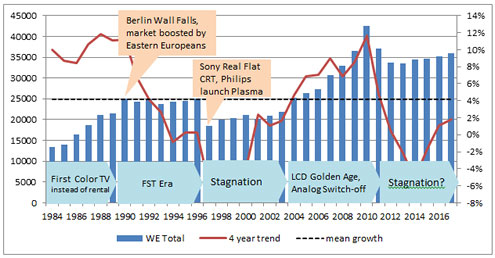4Kx2K TVs: Will They Stimulate or Slow the Market?
By Paul Gray
DisplaySearch
Consumers can react in two ways in a market with rapid innovation: They either get excited by the new value propositions and capabilities and jump in or instead they can opt to wait until winners emerge and choices become simpler.
Looking at the long-term history of the TV market in Western Europe, an intriguing pattern emerges, as shown in the graph. (I am grateful for the help from several TV brands in reconstructing this history.) A rolling four-year trend is included to remove much of the noise from normal economic cycles.

Overall we can see several distinct eras in the market:
- The market was initially driven by consumers buying a first color TV — typically around 20”. In the 1970s, TV rental was common (a set cost as much as a small car in 1972), but economies of scale and intensification of competition as the Japanese entered the market brought prices down.
- There was a brief surge in 1990-1991 as the Iron Curtain fell: Many eastern Europeans spent savings on TVs from western brands, often buying one during a visit. The market then entered a period of stability with only incremental innovation: Widescreen broadcast standards such as PalPlus and MAC failed to gain a foothold and consumers had a choice only between drab matte gray sets with 4:3 screens. However, the new DVD format was wildly successful.
- Sony’s introduction of Real Flat CRT and Philips Plasma TV in 1996-7 had a surprising effect. They both pointed the way to a flat future, but were constrained by supply and cost respectively. The effect on consumers was to render curved CRT sets obsolete but with no affordable alternative. Consumers replaced sets reluctantly, only on failure. As a result, the market stagnated.
- The explosion of thin TVs in big screen sizes and at ever lower prices caused a steady surge in the market; this was further boosted by digital broadcast switch-over and HD services.
- We are now in a time of uncertainty: There is no obvious new force to accelerate the market, 3D has failed to fire consumers’ enthusiasm, while consumers face ongoing reductions in spending power due to weak economic conditions. Furthermore, hot new mass market products such as tablets and smartphones cost the same (or less) than a TV and compete directly for some video usage.
Possibly the worst outcome is that 4Kx2K does indeed catch consumers’ imagination: Its high cost would mean a similar pause in the market like that following Philips first plasma TV in 1997. We will be thinking about exactly this point at the IFA DisplaySearch Business Conference in September.





